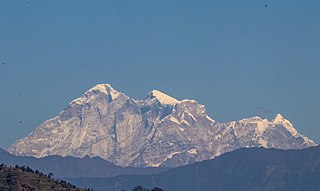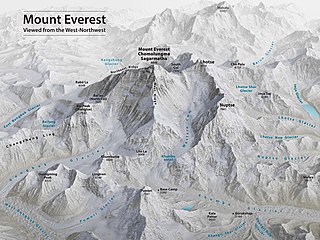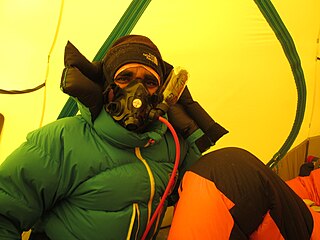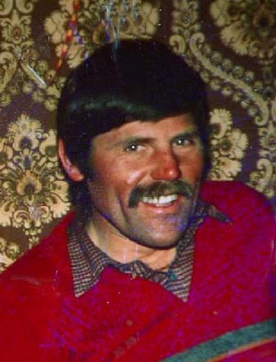Related Research Articles

Lhotse is the fourth-highest mountain on Earth, after Mount Everest, K2, and Kangchenjunga. At an elevation of 8,516 metres (27,940 ft) above sea level, the main summit is on the border between Tibet Autonomous Region of China and the Khumbu region of Nepal.

Dhaulagiri, located in Nepal, is the seventh highest mountain in the world at 8,167 metres (26,795 ft) above sea level, and the highest mountain within the borders of a single country. It was first climbed on 13 May 1960 by a Swiss-Austrian-Nepali expedition. Annapurna I is 34 km (21 mi) east of Dhaulagiri. The Kali Gandaki River flows between the two in the Kaligandaki Gorge, said to be the world's deepest. The town of Pokhara is south of the Annapurnas, an important regional center and the gateway for climbers and trekkers visiting both ranges as well as a tourist destination in its own right.

Gasherbrum I, surveyed as K5 and also known as Hidden Peak, is the 11th highest mountain in the world at 8,080 metres (26,510 ft) above sea level. It is located between Shigar District in the Gilgit–Baltistan region of Pakistan and Tashkurgan in the Xinjiang of China. Gasherbrum I is part of the Gasherbrum Massif, located in the Karakoram region of the Himalaya. Gasherbrum is often claimed to mean "Shining Wall", presumably a reference to the highly visible face of the neighboring peak Gasherbrum IV; but in fact, it comes from "rgasha" (beautiful) + "brum" (mountain) in Balti, hence it actually means "beautiful mountain."

Shishapangma, or Shishasbangma or Xixiabangma, is the 14th-highest mountain in the world, at 8,027 metres (26,335 ft) above sea level. It is located entirely within Tibet. In 1964, it became the final eight-thousander to be climbed.

Anatoli Nikolaevich Boukreev was a Soviet and Kazakh mountaineer who made ascents of 10 of the 14 eight-thousander peaks—those above 8,000 m (26,247 ft)—without supplemental oxygen. From 1989 through 1997, he made 18 successful ascents of peaks above 8,000 m.

Gaurishankar, a mountain in the Nepal Himalayas, is the second highest peak of the Rolwaling Himal, behind Melungtse (7,181 m). The name comes from the Hindu goddess Gauri, a manifestation of Parvati, and her consort Shankar, denoting the sacred regard it is afforded by the people of Nepal. The Sherpas name the mountain as Jomo Tseringma. The Nepal Standard Time (GMT+05:45) is based on the meridian of this mountain peak.

Melungtse is the highest mountain of the Rolwaling Himal in the Himalayas.

Kamet is the second-highest mountain in the Garhwal region of Uttarakhand, India, after Nanda Devi. It is the 29th highest mountain in the world. It lies in the Chamoli District of Uttarakhand. Its appearance resembles a giant pyramid topped by a flat summit area with two peaks.

David Finlay Breashears was an American mountaineer, filmmaker, author and motivational speaker. In 1985, he reached the summit of Mount Everest a second time, becoming the first American to reach the summit of Mount Everest more than once. He is perhaps best known as the director and cinematographer of Everest (1998)—which became the highest-grossing IMAX documentary—and for his assistance in the rescue efforts during the 1996 Everest disaster, which occurred during the film's production.

The Kangshung Face or East Face is the eastern-facing side of Mount Everest, one of the Tibetan sides of the mountain. It is 3,350 metres (11,000 ft) from its base on the Kangshung Glacier to the summit. It is a broad face, topped on the right by the upper Northeast Ridge, and on the left by the Southeast Ridge and the South Col. Most of the upper part of the face is composed of hanging glaciers, while the lower part consists of steep rock buttresses with couloirs between them. The steep southern third of the Kangshung Face also comprises the Northeastern Face of Lhotse; this section may be considered a separate face altogether following the division of the South "Neverest" Buttress up to the South Col. It is considered a dangerous route of ascent, compared to the standard North Col and South Col routes, and it is the most remote face of the mountain, with a longer approach.

Mount Everest is the world's highest mountain, with a peak at 8,849 metres (29,031.7 ft) above sea level. It is situated in the Himalayan range of Solukhumbu district, Nepal.
Carlos Buhler is one of America's leading high altitude mountaineers. Buhler's specialty is high-standard mountaineering characterized by small teams, no oxygen, minimal gear and equipment, and relatively low amounts of funding; yielding first ascents of difficult routes in challenging conditions, such as the Himalayan winter season.
Victor Saunders is a British climber and author. He trained as an architect at the Architectural Association School of Architecture in London. His first book, Elusive Summits, won the Boardman Tasker Prize for Mountain Literature in 1991. He became as a UIAGM/IFMGA ski and mountain guide in 1996 and joined the SNGM in 2003. Saunders first reached the summit of Mount Everest in May 2004, and went on to climb it several more times. In 2020 he became president of the Alpine Club.
Andy Cave is a British mountaineer, mountain guide, and motivational speaker. He was nominated for the Piolet d'Or for his first ascent of the North Face of Changabang in 1997, and won the Boardman Tasker Prize for Mountain Literature in 2005.

Expedition climbing, is a type of mountaineering that uses a series of well-stocked camps on the mountain that lead to the summit, and which are supplied by teams of mountain porters. In addition, expedition climbing can also employ multiple 'climbing teams' to work on the climbing route—not all of whom are expected to make the summit—and allows the use of supports such as fixed ropes, aluminum ladders, supplementary oxygen, and sherpa climbers. By its nature, expedition climbing often requires weeks to complete a given climbing route, and months of pre-planning given the greater scale of people and equipment that need to be coordinated for the climb.

The 1921 British Mount Everest reconnaissance expedition set off to explore how it might be possible to get to the vicinity of Mount Everest, to reconnoitre possible routes for ascending the mountain, and – if possible – make the first ascent of the highest mountain in the world. At that time Nepal was closed to foreigners, so any approach had to be from the north, through Tibet. A feasible route was discovered from the east up the Kharta Glacier and then crossing the Lhakpa La pass north east of Everest. It was then necessary to descend to the East Rongbuk Glacier before climbing again to Everest's North Col. However, although the North Col was reached, it was not possible to climb further before the expedition had to withdraw.

Kharta is a region in Tibet lying to the east of Mount Everest and centred on the Kharta valley and Kama valley. The 40-kilometre (25 mi) Kharta valley starts at the col at Lhakpa La at the head of the Kharta Glacier from which the Kharta Chu river flows east to join the Phung Chu just beyond Khata village. Nearby to the south, the Kama valley starts at the Kangshung Glacier at the foot of Everest's Kangshung Face, and the Kama Chu flows southeast to the Phung Chu. The 1921 British Mount Everest reconnaissance expedition discovered Kharta when reconnoitring ways to climb Mount Everest and managed to reach the North Col via the Lhakpa La. Since that time Kharta has not been used as a way to approach the summit of Everest but the two valleys have become a popular area for trekking.

George Henry Lowe III is an American rock climber and alpinist, noted for his alpine style ascents of difficult and infrequently repeated routes, and his development of traditional climbing routes in the Western United States. He pioneered winter ascents in the North American Rockies along with cousins Jeff Lowe (climber), Mike Lowe, and Greg Lowe. He is also known for his technically difficult ascents of mixed climbing faces in the Himalayas including the North Ridge of Latok I and the first ascent of the East Face of Mount Everest, where the "Lowe Buttress" bears his name. Lowe is currently a resident of Colorado.

Debabrata Mukherjee is an Indian mountaineer and explorer from West Bengal. He was the oldest, first civilian Indian to climb Mount Everest from the North Col. He is also the first person to cross Chaukhamba Col from Badrinath to reach Gangotri.

Franz Oppurg was an Austrian mountain climber. Having climbed from a young age, he became a mountain guide and rescuer, and did a number of first ascents in the winter of mountains in his native Karwendel. He was also the first climber to achieve a solo ascent of Mount Everest.
References
- ↑ Unsworth, Walt (2000). Everest, The Mountaineering History. Seattle, WA, USA: Mountaineers Books. p. 503. ISBN 978-0-89886-670-4.
- ↑ Venables, Stephen. "Stephen Venables". Linked in. Retrieved 27 May 2023.
- ↑ Venables, Stephen. Ollie: The True Story of a Brief and Courageous Life, Hutchinson, 2006, ISBN 009947879X
- ↑ Awards at banffcentre.ca